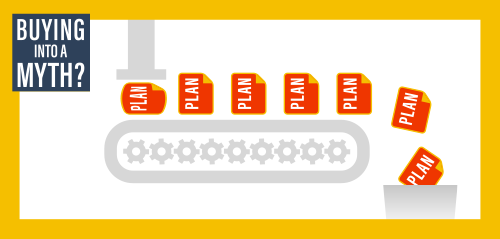BUYING INTO A MYTH?
Marketing Myth #8: Repeating what works will keep on working
We’ve all seen it: a company takes last year’s marketing plan, tweaks it 5% and – presto! – they have this year’s shiny new plan. There’s some logic to this, especially for brands that have found a niche and ridden it to fame and fortune. But history isn’t destiny. And just doing what made you great isn’t likely to work forever.
Breaking from the past
In his classic books Crossing the Chasm and Inside the Tornado, Geoffrey Moore explores the necessity of avoiding a marketing rut. Brands with potentially disruptive products, he says, need to continuously shift their approach. That way they can appeal to different buyer psychologies at different stages of the market development life cycle.
Crossing the chasm to the mainstream
In Moore’s model of the marketing life cycle, companies are likely to go after cutting-edge early adopters first. But for widespread success, they need the pragmatists – those who value innovation as a means to an end, rather than for its own sake.
Pragmatists influence each other, building momentum for a product. To get things rolling, marketers must often demonstrate product value in multiple use cases – and sequence their targeting very deliberately to help the product pick up steam. As more buyers get swept up, the market becomes a tornado of hyper-growth.
Ultimately, conservative buyers (and even laggards) fall in line, sending the product into the mainstream. To achieve this success, however, each phase of market development requires a different kind of innovation.1 Amazon is a great example of a single company reinventing itself repeatedly.
Lessons from a leader
As a marketer, you may be wondering how you can continually adapt through the marketing life cycle like Amazon, especially when some of the innovations above don’t really fall under the umbrella of marketing.
But keep in mind, marketers today have far greater latitude than they did 30+ years ago when Crossing the Chasm was first published.
Many CMOs now lead new product development, customer experience across the enterprise and digital transformation. And they have a seat at the table for decisions about business model reinvention and M&A. All of which puts them in a great position to lead innovation across the market development life cycle.
Feeling a need to break from the past?
In marketing, as in life, history isn’t destiny. It’s just a series of road markers on what should be an ever-changing journey. If you’re feeling like it’s time you took your marketing plan in some exciting new directions, let’s talk ›
1 Geoffrey Moore, “Darwin and the Demon: Innovating within Established Enterprises,” Harvard Business Review, July/August, 2004
Marketing Myth #1: Demand generation is king ›
Marketing Myth #2: Cutting marketing budgets is wise in a recession ›
Marketing Myth #3: Customer loyalty beats customer acquisition ›
Marketing Myth #4: Well-known brands don’t have awareness problems ›
Marketing Myth #5: B2B campaigns should be rational, not emotional ›
Marketing Myth #6: The purchase funnel is still a thing ›
Marketing Myth #7: Marketing is secondary to sales in B2B ›
Marketing Myth #9: Data-driven is always better than people-driven ›



 See what they have to say
See what they have to say